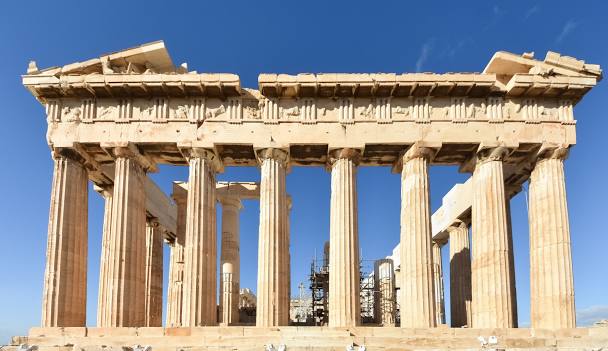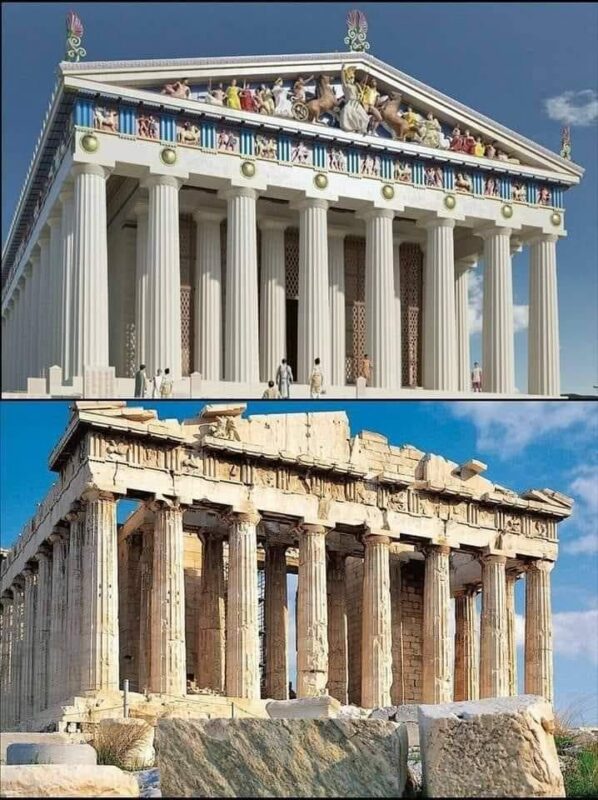The Parthenon, an iconic symbol of ancient Greece, stands atop the Acropolis of Athens as a testament to the brilliance of Greek architecture and culture. Dedicated to Athena, the city’s patron goddess, this majestic temple has captivated historians, architects, and visitors for centuries. Let’s explore the marvels of this ancient masterpiece. Follow archeology.dulichvn.net to discover many hidden mysteries that have yet to be discovered.

A Monument to Athena’s Glory
Architectural Marvel
Structural Innovations
The architects of the Parthenon demonstrated remarkable ingenuity by incorporating subtle adjustments to counteract optical illusions. The columns were slightly bowed, and their tops tilted inward to create the illusion of perfect straightness. These refinements ensured the structure appeared flawlessly balanced and harmonious to the human eye.
Use of Marble
Crafted almost entirely from Pentelic marble, the Parthenon radiates a luminous white glow that has endured through centuries. This high-quality material, combined with the unparalleled skill of ancient Greek artisans, highlights the extraordinary craftsmanship of the era.
Friezes and Sculptures
Adorning the Parthenon are exquisite friezes and metopes that bring Greek mythology to life. Scenes such as the Panathenaic Procession and epic battles between gods and giants reflect the cultural values, religious devotion, and artistic brilliance of ancient Athens, making the Parthenon a timeless narrative in stone.

Legacy of the Parthenon
A UNESCO World Heritage Site
The Parthenon, located at the heart of the Acropolis, stands as a symbol of ancient Greek civilization and is proudly designated as a UNESCO World Heritage Site. Drawing millions of visitors each year, it continues to be celebrated as a cultural and architectural masterpiece that belongs to all of humanity.
Enduring Influence on Architecture
The Parthenon’s design has left a lasting legacy on architecture across the globe, influencing everything from neoclassical buildings to contemporary monuments. Its emphasis on symmetry, proportion, and balance has become a timeless standard for architectural excellence.
Efforts in Preservation
Though it has endured centuries of conflict, natural wear, and looting, ongoing restoration projects ensure the Parthenon’s legacy will remain intact for future generations. These efforts underscore the monument’s lasting significance as a symbol of cultural heritage and historical identity.
See more: The Karakoram Highway: An Engineering Marvel Connecting Pakistan and China
Conclusion
The Parthenon, perched majestically atop the Acropolis of Athens, is more than just an architectural marvel; it is a symbol of the ingenuity, creativity, and devotion of the ancient Greeks. Built in the 5th century BC during the height of the Athenian Empire, this temple dedicated to the goddess Athena showcases the pinnacle of Greek architectural design. Its perfect proportions, use of the Doric order, and meticulous attention to detail reflect the advanced engineering and artistic vision of the time.
Beyond its physical beauty, the Parthenon holds immense cultural and historical significance. It was not only a religious site but also a powerful representation of Athens’ power, democracy, and artistic achievements. Over the centuries, the Parthenon has withstood the ravages of time, including wars, looting, and natural disasters, yet it continues to stand as a proud testament to the brilliance of ancient Greece. Today, it serves as an enduring connection between the modern world and the classical past, inspiring awe in visitors from around the globe who marvel at its legacy.
As one of the most recognizable symbols of ancient civilization, the Parthenon transcends time, remaining a beacon of human accomplishment and creativity. Its cultural impact continues to influence art, architecture, and philosophy, making it a timeless monument that unites humanity in admiration for the achievements of the ancient world.



CÁC TIN KHÁC
Mary Walton: The Forgotten Inventor Who Helped Clean Up America’s Cities
Tomb of Queen Nefertari in the Valley of the Queens, Egypt
Discover the Hypostyle Hall of the Temple of Hathor at Dendera
Venus de Losange: Unveiling the Mystery of a 20,000-Year-Old Paleolithic Icon